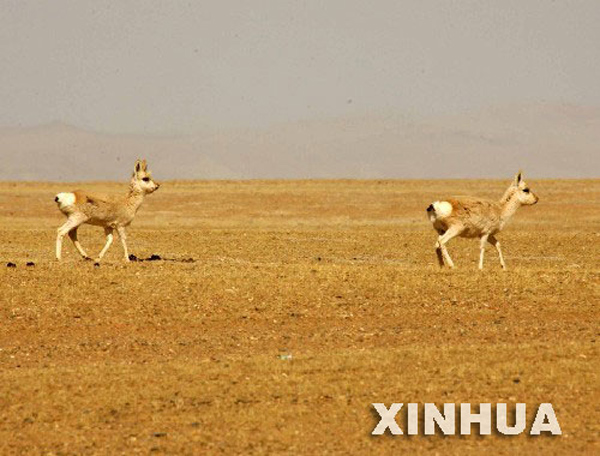Nature reserves work together to protect Tibetan antelopes
Four leading nature reserves in western China have vowed to work together to protect Tibetan antelopes, an endangered species on the Qinghai-Tibet Plateau.
 |
|
Tibetan antelopes [File Photo] |
The four nature reserves, including two in the northwestern Qinghai Province, one in Tibet Autonomous Region and one in Xinjiang Uygur Autonomous Region, will carry out joint patrols in the antelopes' habitats to guard against poaching.
"We'll also carry out joint research and personnel exchanges to share our experience in antelope protection," said Tseten Druk, director of the Hoh Xil national nature reserve administration in Qinghai Province.
He made the remarks at a seminar on Tibetan antelope conservation with experts from the four nature reserves Tuesday in Xining, capital of Qinghai Province.
All the four reserves are located at an average altitude of over 4,000 meters and are ideal habitats for Tibetan antelopes and other wildlife species including wild yaks and wild Tibetan donkeys.
Their collaboration was aimed at creating a safer environment for Tibetan antelopes during their massive seasonable migration, said Tseten Druk.
"We had some exchanges in the past," said Wu Haipeng, a forestry official in Ngari Prefecture of Tibet. "But we need to intensify cooperation and club together to form a stronger force."
Every nature reserve in China faces lack of funds, manpower and facilities.
In Hoh Xil, only 19 forestry workers patrol the 45,000-square meter reserve. A patrol takes at least a week.
"We have only a few old Beijing-made jeeps and when a vehicle breaks down, it's hard to get help because the reserve is not covered by any mobile telecom networks," said Tseten Druk.
Tibetan antelopes are mostly found in Tibet, Qinghai Province and the western part of Xinjiang Uygur Autonomous Region.
Pregnant females and young members of the herd migrate to the Hoh Xil region of western Qinghai and northeastern Tibet every June to give birth, and make the return journey in September. The migration covers about 530,000 square kilometers.
There used to be millions of Tibetan antelopes on the Qinghai-Tibet Plateau, but excessive hunting and human encroachment on their habitat caused their population to plummet in past decades.
Poachers hunt the antelopes for their hide as it can be sold and made into shahtoosh shawls, a luxury item that requires three to five antelope skins to make just one shawl.
Since 1979, the animal has been recognized as an endangered species and protected under the Convention on the International Trade in Endangered Species.
Chinese conservation officers launched a campaign to crack down on illegal poaching of Tibetan antelopes in 1999 in Hoh Xil, a reserve that encompasses China's largest area of uninhabited land.
The region became well known following the release of the award-winning feature film, "Kekexili Mountain Patrol" by Chinese director Lu Chuan. It tells the true story of a journalist who joined a Tibetan volunteer patrol chasing poachers trading in antelope skins in Hoh Xil, which is spelled Kekexili in Mandarin.
 0
0 






